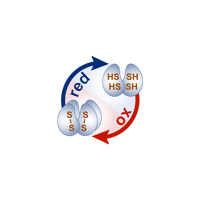Chaperone-mediated organismal redox control and proteostasis regulation
The accumulation of reactive oxygen species (ROS) has been long known to be associated with cellular dysfunction and the onset and progression of many age-associated diseases. Although efficient antioxidant systems have evolved to protect organisms from oxidative challenges, ROS levels can exceed the antioxidant capacity and damage all cellular components, including proteins [1]. Oxidative protein unfolding can result in potentially toxic protein aggregation which endangers the integrity of the entire cell. Redox-regulated chaperones, which become activated upon oxidative unfolding stresses, serve as a first line of defense to protect the proteome form wide-spread aggregation [2].
While stress-activated chaperones have been shown to be crucial for the resistance against proteotoxic stress in unicellular organisms, such as bacteria, yeast and trypanosomatids [3-6], we aim to better understand their tissue-specific role of the highly conserved redox-regulated chaperone and targeting factor Asna1 (yeast Get3) in maintaining the redox balance and proteostasis in C. elegans. Using genetically encoded redox probes as well as fluorescently labeled proteostasis sensors, we study the tissue-specific function of well-characterized mutant variants [5,6] and apply a proteomic approach to reveal folding-sensitive proteins depending on Asna1. Manipulating Asna1 levels in neurons and muscles, we examine effects on other tissues and monitor motility, brood size, lifespan and stress resistance.
1. Ulrich K and Jakob U (2019) The role of thiols in antioxidant systems. Free Radic Biol Med, 140: 14-27. DOI: 10.1016/j.freeradbiomed.2019.05.035
2. Ulrich K, Schwappach B, and Jakob U (2020) Thiol-based switching mechanisms of stress-sensing chaperones. Biol Chem, 402(3):239-252. DOI: 10.1515/hsz-2020-0262
3. Becker SH, Ulrich K, et al. (2020) Mycobacterium tuberculosis Rv0991c is a novel redox-regulated molecular chaperone. mBio, 11(4):e01545-20. DOI: 10.1128/mBio.01545-20
4. Currier R B*, Ulrich K*, et al. (2019) An essential thioredoxin-type protein of Trypanosoma brucei acts as redox-regulated mitochondrial chaperone. PLoS Pathog, 15(9):e1008065. DOI: 10.1371/journal.ppat.1008065
5. Ulrich K, et al. (2022) From guide to guard – Activation mechanism of the stress-sensing chaperone Get3. Mol Cell, 82(17):3226-3238.e7. DOI: 10.1016/j.molcel.2022.06.015.
6. Voth W, et al. (2014) The protein targeting factor Get3 functions as ATP-independent chaperone under oxidative stress conditions. Mol Cell 56, 116-127. DOI: 10.1016/j.molcel.2014.08.017
